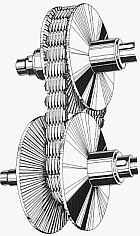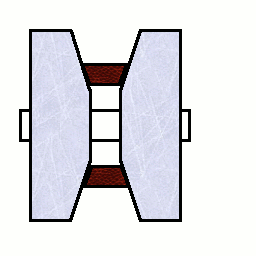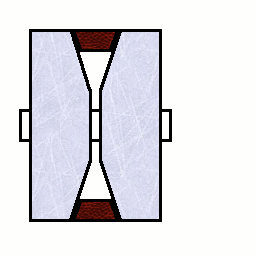Difference between revisions of "Variomatic"
m |
|||
| Line 1: | Line 1: | ||
| − | + | {{X}} | |
| − | |||
{{Transmission types}} | {{Transmission types}} | ||
[[Image:Pivgetriebe.png|thumb|150px|Variomatic]] | [[Image:Pivgetriebe.png|thumb|150px|Variomatic]] | ||
| + | |||
| + | |||
'''Variomatic''' is the stepless, fully [[automatic transmission]] of the [[Netherlands|Dutch]] car manufacturer [[DAF Trucks|DAF]], using a drive belt and two [[pulley]]s. It was the first [[continuously variable transmission]] (CVT) (as opposed to shifting between separate gears). In theory, this always produces the optimum [[torque]]. The variomatic was introduced by DAF in 1958, also putting an automatic gear box in the Netherlands for the first time. The variomatic was introduced on the [[DAF 600]]. Because the system does not have separate gears, but one (continuously shifting) gear and a separate 'reverse mode' (as opposed to a reverse gear), the gear works in reverse as well, giving it the interesting side-effect that one can drive backwards as fast as forwards. As a result, in the former Dutch annual backward driving world championship, the DAFs had to be put in a separate competition because no other car could keep up. Thus, these very cheap and simple cars were the 'formula one' in this competition. | '''Variomatic''' is the stepless, fully [[automatic transmission]] of the [[Netherlands|Dutch]] car manufacturer [[DAF Trucks|DAF]], using a drive belt and two [[pulley]]s. It was the first [[continuously variable transmission]] (CVT) (as opposed to shifting between separate gears). In theory, this always produces the optimum [[torque]]. The variomatic was introduced by DAF in 1958, also putting an automatic gear box in the Netherlands for the first time. The variomatic was introduced on the [[DAF 600]]. Because the system does not have separate gears, but one (continuously shifting) gear and a separate 'reverse mode' (as opposed to a reverse gear), the gear works in reverse as well, giving it the interesting side-effect that one can drive backwards as fast as forwards. As a result, in the former Dutch annual backward driving world championship, the DAFs had to be put in a separate competition because no other car could keep up. Thus, these very cheap and simple cars were the 'formula one' in this competition. | ||
Latest revision as of 22:28, 3 July 2009
| Transmission types |
|---|
| Manual |
| Continuously variable |
| Bicycle gearing |
Variomatic is the stepless, fully automatic transmission of the Dutch car manufacturer DAF, using a drive belt and two pulleys. It was the first continuously variable transmission (CVT) (as opposed to shifting between separate gears). In theory, this always produces the optimum torque. The variomatic was introduced by DAF in 1958, also putting an automatic gear box in the Netherlands for the first time. The variomatic was introduced on the DAF 600. Because the system does not have separate gears, but one (continuously shifting) gear and a separate 'reverse mode' (as opposed to a reverse gear), the gear works in reverse as well, giving it the interesting side-effect that one can drive backwards as fast as forwards. As a result, in the former Dutch annual backward driving world championship, the DAFs had to be put in a separate competition because no other car could keep up. Thus, these very cheap and simple cars were the 'formula one' in this competition.
Manual transmission remained dominant in Europe. When DAF was taken over by Volvo, the Variomatic patents were transferred to a company called VDT (Van Doorne Transmissie), later taken over by Bosch. Audi reintroduced an improved version of the variomatic in the early 21st century under the name Multitronic. This system uses a metal belt and lacks a limit to the number of gears available, switching between them without noticeable shocks. These metal drive belts are the most important part of CVT. The only factory still producing these belts, the Bosch factory in the Netherlands, produced the ten millionth belt on 9 May 2007. It is used in over 40 car models, these days even including expensive brands like Mercedes.
The final drive has two pulleys with moveable conical drums. The distance between the drums is controlled by the engine vacuum in the inlet manifold and engine RPM, through centrifugal weights inside the drums. Between the two pulleys runs a drive belt. As a result of change in the distance of the conical drums in both pulleys, the diameters and so also the reduction ratio changes continuously.
With the DAF 600 - 55 each rear wheel was propelled individually by a pair of conical drums and drive belt with the effect of a limited slip differential: if a drive wheel on slippery road revs up, the other wheel can still transfer the full torque. This results in unusually good traction characteristics, which were also a reason for successes of the DAFs in rallies. It was even used in a Formula 1 car, but it was only allowed to start in one race before it was banned since it gave an unfair advantage. There were several disadvantages that accompanied the lack of a true differential gear. Although each belt could settle (independent of the other) into it's optimum position, thus allowing for wheel speed variation, the system was slow to operate and depended on the pulleys being turned. This led to rapid tire wear and placed stress on other transmission components. Snapped drive shafts were common. Low speed handling in icy conditions was interesting as the system tended to drive the car forward against the influence of the steered wheels. Later cars, the 46, 66 and Volvo variants were fitted with a differentially geared axle.
The Variomatic is also used in today's motorscooters. It is a standard part of all common scooters since 1985, and several companies such as Malossi, Polini, Doppler and Stage6 are offering tuning clutches and variomatic for most common 50, 70 and 125 cc scooters.
A version of the Variomatic called Transmatic is still made by DAF's Van Doorne's Transmissie b.v. in Tilburg, The Netherlands and Nissan Primera is offered with this transmission.
Today the Continuously Variable Transmission (CVT) works according to the same principle. Rather than rubber drive belts, the modern transmission is made much more durable by the use of steel link belts. The CVT is available in cars such as Audi, Honda and the MINI ONE and MINI Cooper.


